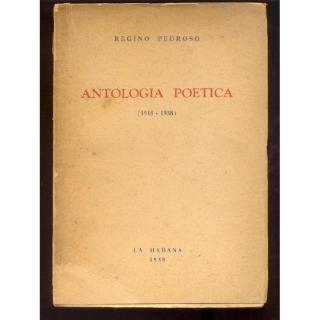4.1.1.10.1 First lyrical forays of Regino Pedroso (1896 – 1983)

Regino Pedroso was trained within the canons of modernism and its sequel in Cuban lyric poetry, publishing his first verses in “El Fígaro”, “Castalia” and “Chic”, between 1919 and 1920. In a more elaborate style but without abandoning this aesthetic, the poetry collections “La ruta de Bagdad y otros poemas” (The Route of Bagdad and Other Poems) from 1923 and “Las canciones de ayer” (Yesterday’s Songs) from 1926 were conceived.
These texts are exponents of the aforementioned tendency, relevant only for the authenticity of Pedroso’s Orientalism, which, rather than exoticism, constitutes an attempt to explore the genetic roots of his Asian ancestry. This propensity for the Oriental would be taken up again in later poems, but not so much from an exotic perspective as from an ancestral repository of popular wisdom, especially from China.
Regarding this period of Pedroso’s creativity, Eugenio Florit writes: “Our poet had lived in a fantastic world, like the Arabian Nights; what was oriental in him seemed to emerge from his pen then in a riot of colors, sumptuous silks, marbles, and jewels; all of this set in the irreproachable form of the hendecasyllabic or Alexandrine sonnet; all of this within a framework of noble and luminous words; all of this, in short, within the general tone of modernism.”
Both texts are eminently modernist and return again and again to these topics, with a tone of slight eroticism, of sensuality perfumed with dreamlike substances and adorned with strings of rare stones, in short, the topics most dear to modernism, already hackneyed, but which are saved by the author’s authenticity in handling these symbols, which had not been exhausted for his peculiar sensitivity.
Love, death, and essential human themes are somehow present in this work, which already establishes sensoriality as a privileged aspect of poetic expression, a concept that would remain despite the subsequent thematic break. In “La ruta de Bagdad,” a sonnet appears that encapsulates Pedroso’s main leitmotif during this period, along with his mastery of closed verse structures and aesthetic sculpting:
“It was under the splendor of a morning
of silk and pale flashes:
the caravan crossed under the sun
to the slow nodding of the camels.
A sweet Muslim laziness
wrapped us in its restlessness, and beautiful
the fingers of your sultana’s hand
they pulled the hair from their necks.
On the road to Baghdad it was a day…
The love in your eyes blossomed
your crazy fevers, already defeated at your feet,
slave in your fascinating pupils,
my lips implored supplicantly
a love without death and oblivion.”
Regino Pedroso’s modernist cultivation of poetry, although marked by aesthetic revelry and constituting the initial hallmark of his poetics, with the enthusiasm that this aroused in any young person, soon gave way to the push of a social concern, primarily with a working-class theme, cemented through his life as a member of this social class and keen observer of the collective pains derived from this condition and character, neglected from a political point of view.








